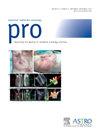局部前列腺癌的靶体积优化
IF 3.4
3区 医学
Q2 ONCOLOGY
引用次数: 0
摘要
一直以来,前列腺癌的治疗除了需要前列腺和邻近精囊的位置外,几乎不需要其他解剖信息。由于手术标本中多灶性癌症的发生率较高,且无法通过成像精确定位单个肿瘤病灶的边界,因此放射治疗通常针对整个前列腺。前列腺磁共振成像(MRI)和使用前列腺特异性放射性同位素的正电子发射断层扫描(PET)的发展开创了一个时代,使放射肿瘤学家能够对前列腺中的高风险灶进行定位和局部剂量递增。最近的 III 期数据表明,采用病灶剂量升级可提高生化控制率,而不会显著增加毒性。然而,关于最佳靶体积定义和处方策略,仍有许多问题有待解决。在这篇综述中,我们总结了目前关于基于图像的 MRI 和 PET 病灶靶点划分的文献。我们的综述包括关于扩散解剖模式的可用数据总结,为临床目标体积定义的临床判断提供依据。我们指出了主要的知识差距,并对新的实施策略提出了建议。本文章由计算机程序翻译,如有差异,请以英文原文为准。
Target Volume Optimization for Localized Prostate Cancer
Purpose
To provide a comprehensive review of the means by which to optimize target volume definition for the purposes of treatment planning for patients with intact prostate cancer with a specific emphasis on focal boost volume definition.
Methods
Here we conduct a narrative review of the available literature summarizing the current state of knowledge on optimizing target volume definition for the treatment of localized prostate cancer.
Results
Historically, the treatment of prostate cancer included a uniform prescription dose administered to the entire prostate with or without coverage of all or part of the seminal vesicles. The development of prostate magnetic resonance imaging (MRI) and positron emission tomography (PET) using prostate-specific radiotracers has ushered in an era in which radiation oncologists are able to localize and focally dose-escalate high-risk volumes in the prostate gland. Recent phase 3 data has demonstrated that incorporating focal dose escalation to high-risk subvolumes of the prostate improves biochemical control without significantly increasing toxicity. Still, several fundamental questions remain regarding the optimal target volume definition and prescription strategy to implement this technique. Given the remaining uncertainty, a knowledge of the pathological correlates of radiographic findings and the anatomic patterns of tumor spread may help inform clinical judgement for the definition of clinical target volumes.
Conclusion
Advanced imaging has the ability to improve outcomes for patients with prostate cancer in multiple ways, including by enabling focal dose escalation to high-risk subvolumes. However, many questions remain regarding the optimal target volume definition and prescription strategy to implement this practice, and key knowledge gaps remain. A detailed understanding of the pathological correlates of radiographic findings and the patterns of local tumor spread may help inform clinical judgement for target volume definition given the current state of uncertainty.
求助全文
通过发布文献求助,成功后即可免费获取论文全文。
去求助
来源期刊

Practical Radiation Oncology
Medicine-Radiology, Nuclear Medicine and Imaging
CiteScore
5.20
自引率
6.10%
发文量
177
审稿时长
34 days
期刊介绍:
The overarching mission of Practical Radiation Oncology is to improve the quality of radiation oncology practice. PRO''s purpose is to document the state of current practice, providing background for those in training and continuing education for practitioners, through discussion and illustration of new techniques, evaluation of current practices, and publication of case reports. PRO strives to provide its readers content that emphasizes knowledge "with a purpose." The content of PRO includes:
Original articles focusing on patient safety, quality measurement, or quality improvement initiatives
Original articles focusing on imaging, contouring, target delineation, simulation, treatment planning, immobilization, organ motion, and other practical issues
ASTRO guidelines, position papers, and consensus statements
Essays that highlight enriching personal experiences in caring for cancer patients and their families.
 求助内容:
求助内容: 应助结果提醒方式:
应助结果提醒方式:


